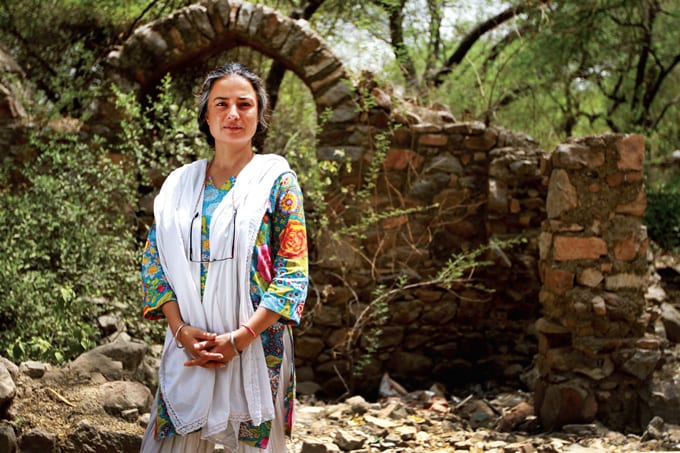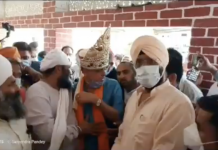


HERITAGE SITES are the new theatre for property wars. In a global economy, shared history is about capital, about control over who makes the money. Conservationist Gurmeet Rai, 45, the director of the Cultural Resource Conservation Initiative in Delhi, tells Revati Laul about the struggles to preserve our vast natural and cultural heritage from those who couldn’t care less.
EDITED EXCERPTS FROM AN INTERVIEW
Why is our vast heritage either derelict or cast away? What are we not getting right about preserving it?
When we’re talking of preserving both nature and culture, unfortunately in our country, the legal framework is very archaic. Worldwide, a whole regime exists, of protocols and recommendations. But, unfortunately, our legal and planning instruments do not take cognizance of such things. Now when we’ve chosen to globalise, and the private sector is generating a lot of money and has a lot to invest in public assets, we should be looking at protection in terms of potential public-private partnerships (PPPs). But our instruments of planning, of equity, all the things we need to worry about, are not being adequately developed.
What exactly do you mean when you say we need to plan better?
Well, unfortunately, the 20th century has seen the death of the planner. Things are built so rashly, without adequate thought or planning or an examination of their long-term sustainability. Even UNESCO says conservation cannot happen without the participation of the people, but our government processes do not allow for public consultation and are totally inflexible. For instance, in a project we were working on in Ellora, we were looking at a site management plan for the Verul village in the vicinity. We were talking about working with the villagers in the cleaning of the Yelganga river in the area, replenishing the ground water etc. Conservation and protection isn’t just about the Ellora caves, it’s about protecting the whole cultural ethos. But the authorities turned around and told us, “We only work on the monument. For the rest you have to talk to the government of Maharashtra.” India is a disaster as far as planning is concerned. As a conservation professional, I’m furious with the lack of governance.
Should the government involve the private sector in conservation? How should this be done?
In India, we don’t have a policy for PPPs. Especially in the sector of public good, the government shouldn’t be encouraged to put assets out in the market without taking responsibility for the kind of plans they produce. A lot of cultural heritage projects end up in court because so many scams today are related to land and property. And it’s easy even for good intentions to get embroiled in litigation. A lot of my projects are in litigation.
Like which projects? What exactly happened?
The Qila Nabha in Punjab is one such. I was representing the private sector and we came up with a proposal for the fort of Nabha. Since the public works department had not been proactive in developing a plan to restore the fort, the private sector came up with a plan. But someone said, “These guys are out to grab land and they’ll build a mall here.” Over the next four years, we were in court. Finally, the court gave a historic verdict that confirmed private sector investment in cultural heritage as a good thing. Having said that, I think we got lucky on this one. Because there’s another public-private project to restore the Minto Wall in Bhopal in Madhya Pradesh. It was a PPP and again somebody filed a PIL and I don’t think that has been sorted out yet.
If the private sector is to invest in restoration, how can it avoid projects being stuck in court?
My answer would be that the government needs to make a list of monuments and grade them. Grading is a way of working out the kind of interventions that are permissible. Grade 1 could be your Taj Mahals of the world. Grade 2 monuments can have other uses with strict stipulations on the type of use, while for Grade 3 monuments, the stipulations are more relaxed. Once you’ve graded monuments, you go forward and make plans for them. Right now, no universal principles exist as a guide for PPPs.
When we’re talking about conservation of monuments becoming theatre for lawsuits, religious sensitivities also play a huge role. How do you prevent potential Babri Masjids or Ram Setus?
Often with sites like the Babri Masjid and Ram Setu, agendas are hijacked so that the voices of people for whom the site means something get lost. I worked on a mosque in Punjab built by the Sikh Guru —Hargobind. The Muslims, who used the mosque moved during Partition, and Nihang Sikhs, who had been associated with Guru Hargobind, decided to look after the mosque. When we started working on the restoration of the mosque, there were allegations that we were converting a mosque into a Gurdwara. MP Mohammad Shahabuddin brought this up in Parliament. I talked to the Waqf board and we got an MoU signed to say that the Nihang Sikhs would look after the mosque because it was built by their guru. Access would, of course, be given to Muslims. Both parties agreed that the property could not be divided because that would violate its syncretic tradition.
Dealing with the Waqf board and Nihang Sikhs must have been difficult. It could so easily have been blown out of proportion.
All the ingredients for a religious conflict were there. We were restoring two shared sacred spaces. One was a mosque and the other was a Krishna temple looked after by the Sikh community. The temple belonged to a Thakur family in the village. The family left the village in 1984 because of riots and sold all their land. The only thing they didn’t sell was the temple. It had the most beautiful wall paintings of the Sikh gurus, Maharaja Ranjit Singh, Lord Shiva — all in this Krishna temple. We went in there not realising the layers of contested narrative that would emerge. The Jat Sikhs in the area were wondering why this temple was being restored. False cases were registered against us. So we put in place rules to ensure what we were doing wouldn’t be misconstrued. Rule one: only talk conservation. Two: do not talk about a third person behind their back. Three: no political conversation. Four: do not accept social invitations from an yone in the village. We learned that if you want to preserve cultural heritage, you need to apply firm principles, to prove a point about equity and rights.




keep it up